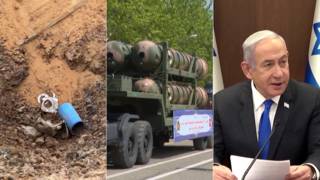
Related
We discuss the latest in the ongoing US war in Afghanistan—the longest running war in American history—with Tom Engelhardt, creator and editor of the website Tomdispatch and author of “The American Way of War: How Bush’s Wars Became Obama’s.” Engelhardt says the U.S. war in Afghanistan has troubling parallels with the Soviet occupation of Afghanistan of the 1980s.
Watch Part I of this interview HERE.
TRANSCRIPT
AMY GOODMAN: This is Democracy Now!, democracynow.org, the War and Peace Report. I’m Amy Goodman, with Juan Gonzalez, with our web exclusive with Tom Engelhardt. His book is just coming out now; it’s called The American Way of War: How Bush’s Wars Became Obama’s. Last week, the top US and NATO commander in Afghanistan, General Stanley McChrystal, said he expected violence and casualties will increase in the coming months.
GEN. STANLEY McCHRYSTAL: Well, I think that we are pressuring the enemy, and I think they are reacting to that. As we predicted, violence would go up, the more places we were, the more forces that we use to take the momentum away from the enemy. I think it’s likely that our casualties and violence will continue to rise, particularly through the summer months. They could rise well into the fall.
AMY GOODMAN: That is Stanley McChrystal, General McChrystal. Tom Engelhardt, you do TomDispatch.com. You’ve got your new book, The American Way of War. Chapter three is “Air War, Barbarity, and Collateral Damage.” Talk about McChrystal’s comments and what’s happening in Afghanistan.
TOM ENGELHARDT: Yes, the reality of modern war, from the early twentieth century on, is that what we call collateral damage has increasingly become the central damage of the war. Collateral damage means damage to civilians. But as war has progressed into our time, you could really say that the soldiers, increasingly, on either side, are the collateral damage, and increasingly, the civilians are the central damage of any war. We can’t count — I mean, we have no idea, despite the counts that you see of actual Afghan deaths, for instance. I mean, who knows what’s happening in small villages we haven’t heard about?
Americans, except on our drone planes, which are kind of sexy, these our new wonder weapons, we pay no attention to air war. But we’ve, in both Iraq and Afghanistan, we’ve bombed, you know, countysides. We’ve bombed cities in Iraq. And in the case of TomDispatch, I think I may be the only website in the United States or on the planet — I don’t know — that’s tried to count the number of wedding parties that American — the American Air Force has knocked out in Iraq and Afghanistan. I got up to about seven. I find this shocking. But here, we are incredibly detached from the wars that we fight. And as long as we are thinking in terms of our own safety, we think very little about wedding parties, funerals, baby naming parties. I mean, all of these things can — are because air war is the least — despite what you hear about smart bombs and, you know, precision-guided weaponry, if you’re going to fight from the air — and that is part of the American way of war — you are going to kill civilians, period. And you’re going to probably kill them in greater numbers than any other way. That’s just a fact of war, I would say.
JUAN GONZALEZ: I’d like to get back to this question you raise of the garrison state.
TOM ENGELHARDT: Yes.
JUAN GONZALEZ: And obviously, as the United States moved more and more toward a professional, as opposed to a drafted, army, more Americans have become disconnected from the reality of the American military machine around the world. But how extensive is the garrison state? Or, remind some of our viewers and listeners about that.
TOM ENGELHARDT: It’s very striking. I mean, the Pentagon, depending on what year you look at the reports, they 'fess up to 700-odd sites, they call them, bases large and small. And these go from fairly small sites, or places where they may even cache weapons or something without a lot of human beings, to what in essence are enormous American towns. I mean, at one point, Balad Air Base in Iraq, with maybe 20,000 people there — troops, contractors, whatever — had the air traffic of O'Hare Airport in Chicago. I mean, these are enormous places, you know, fifteen, twenty miles around, with bus routes, [inaudible], massage parlors. You know, some of them are quite extraordinary. And those 700-odd bases don’t include, in fact, Balad. They don’t include bases in war zones. We had, at our height, about 300 bases, large to small, in Iraq. And we have been in a building frenzy since the surge in Afghanistan. So we have now, Nick Turse of TomDispatch has estimated, 400 bases — these are from micro to macro — in Afghanistan. And we’re not stopping. To give you a simple example, the Special Forces, Army Special Forces, are supposed to get a $100 million base built for them, you know, seventeen acres in northern Afghanistan, which will be done — since it’s just starting now, it will be done about the time that President Bush — that’s an interesting slip — President Obama claims that we’re going to start withdrawing troops from Afghanistan. So our basing around the world is — it’s really staggering. I would guess, maybe if you include war zones and also countries that don’t admit — it’s just uncomfortable. Jordan doesn’t want to say there’s an American base there; it’s just awkward. Pakistan, we share bases, so not counted as a base. Maybe 1,200 or more. That would be my guess, including the war zones.
And this is unprecedented historically. I mean, I think Britain had forty bases around the world. The Romans, to go back to, since these are the two things that we were compared to back in 2003, 2004, thirty-seven or thirty-eight. I mean, that was a lot then. There’s nothing like this. I mean, and we, of course, don’t take territory. It’s a very odd kind of imperial structure. We take bases. There are gunboats pushed deep into land. The gunboats that the Europeans used to take much of the world, seventeenth, eighteenth, nineteenth century, these are our land gunboats. That’s really what they are.
AMY GOODMAN: We’re talking to Tom Engelhardt. You write about the Bush legacy, what Bush did wrong, and then you move to Obama’s war.
TOM ENGELHARDT: Yeah, I do. Well, I mean, what’s interesting is you’ve got two men who couldn’t, in many ways — I think we can agree, we’re not talking about Tweedle Dum and Tweedle Dee. We’re talking about two people with remarkably different personae, thought processes and whatever. What’s startling is, given all that and given that they’re coming at each of these problems, the war problems, from a different perspective, how often they land at the same place. And I think that tells you that there’s a kind of momentum, like the momentum to build that base in northern Afghanistan. There’s a war momentum, which has the potential to sweep any president along, you know?
I mean, in fact, the Obama administration has followed the policies of, really, the last part of the Bush administration, both in Iraq and Afghanistan, and maybe even hiked Afghanistan farther than the Bush people would. I mean, the surge in Afghanistan, we usually hear about 30,000 troops. That’s what’s talked about. But the actual surge in Afghanistan was — it was a surge in troops. It was a surge in CIA operations. It was a surge in special forces operations. It was a large surge in contractors. There was a large surge in base building. There was a significant surge in trying to send in State Department people and, when they couldn’t find them, Pentagon people, etc., etc., etc. So, the level of the surge in this war is bigger than we imagined, and it does seem like a kind of war momentum. And it does seem to me as if we are in both a war state, with Washington as the war capital, and an eternal, permanent state of war at this point. And Americans are largely unaware of that.
JUAN GONZALEZ: And yet — you mentioned the surge in Afghanistan — the progress is almost invisible. There was a startling article in the Washington Post a few days ago about the situation in Marjah, where supposedly the Agency for International Development has funding for 10,000 jobs for the local citizens, but they’re having trouble recruiting people. They tried to organize a women’s group in the town, and no women would show up. They were ready to provide water pumps, hundreds of water pumps for residents, and no one would take them, because they were afraid that the water pumps would be a sign to the Taliban that they were collaborating with the US government. So, in essence, even the pacification efforts of the government are failing in the town that they noted as the example of where they were going to roll back the gains of the Taliban.
TOM ENGELHARDT: Yeah, this was to be the success, and then they were to move on to Kandahar. Now, this area, Marjah, that you’re talking about, it was presented as a city or a town of 80,000 people. It seems clearly now to be a set of connected agricultural villages of maybe 35,000 to 40,000 people. We threw 15,000 troops in, which should, from a counterinsurgency handbook standpoint, be right — you know, about one troop for every two or three people in the area. And, as you say, it’s not worked.
Now, our next offensive, theoretically, recently delayed, is to be in Kandahar. But think of Kandahar as Detroit. I mean, numbers are almost unknown in Afghanistan, but Kandahar has between 500,000 a million people. It’s an enormous city. It’s not a Taliban-controlled city, either, weirdly enough, when we say we’re going to take it. It’s in some in-between state. And I think the truth is that we have a — in Afghanistan, we have a set of tactics, which we call counterinsurgency. They’re procedures, you might say, and they’re out of a kind of a warmed-over Vietnam textbook. But I think basically that this administration and its soldiers, they’re in a kind — you know, they talked about rolling out a government in a box. That was what our war commander said in Marjah. They’re in a kind of a box. I talked to a journalist coming back from Afghanistan recently, who said, you know, they cannot see outside the American box in Afghanistan. And I honestly don’t think they know what they’re doing.
The Bush people, the one thing you can say about them is they were visionaries, in a sense. I mean, they were —- you might call them mad visionaries, but they had a vision of the whole planet. It was a geopolitical vision. It involved energy flows, what countries you would take, who you would roll back. It involved the use of American power. It led to various disasters. This administration is, like, managing that war momentum, but I actually don’t think they have a large vision at all of how the world is working. I don’t feel any of that. I feel a deep sense of confusion. And in Washington, there is starting to be some discussion of that now, of the actual strategic confusion of the Bush administration. So I think things look pretty [inaudible] -—
JUAN GONZALEZ: Of the Obama administration.
TOM ENGELHARDT: Of the Obama administration. You know, I don’t feel —-
JUAN GONZALEZ: You keep slipping.
TOM ENGELHARDT: I don’t feel the two men are similar at all, but their war policies are so similar it’s hard for me not to say that. It’s true. I mean, it’s just startling that their war policies aren’t different.
AMY GOODMAN: Well, you know, I’m thinking of Helen Thomas’s last questioning of President Obama, when she asked about why we’re in Afghanistan and talked again about the casualties and who will keep raising these questions. But Obama gave a lesson on, well, we’re attacking the enemy. We’re attacking those that attacked us on September 11th, and we must prevail.
TOM ENGELHARDT: Yeah, it’s that same -— it’s the same line about al-Qaeda. I mean, the advantage of al-Qaeda, if you look at it again in the Soviet perspective — the Soviet Union disappeared, and there was no enemy left in the world. A few rogue states, like North Korea, who became the Axis of Evil, sooner or later. But they were very small. They were like — they were like just shrimps in the world. The advantage of al-Qaeda — which really was a ragtag outfit of, you know, a few thousand people scattered around the world, and, you know, some in Afghanistan — after 9/11 was it could be blown up to any size. So it was a very convenient enemy to begin to enter a kind of a war state. And it’s remained that way.
I think, quite honestly, the real question in Afghanistan is not are we doing well or are we doing badly, but why are we doing anything in Afghanistan, when, you know, it is the most — it is the backlands of the world. That money, we desperately need here. And the truth is, we would be a lot safer in a million different ways, if in fact, in 1991, we had not put our money into the military and the military-industrial complex, we had put it into a peace dividend. Imagine where we’d be now, you know? Just as in 1979 with Carter, if anybody had listened to him in that famed “malaise” speech when he had called for alternative energy research, you know, I mean, we’d be in a different world.
But these moments were missed, and we plowed down this military road, and it’s left us in distant wars that, I think at this point, why they’re being managed, nobody really understands. Nobody can imagine getting out, but nobody can — I mean, nobody up there — but nobody can imagine quite why we’re doing it. So they still mention al-Qaeda. Al-Qaeda is real, but, you know, they’re not really fighting a war against al-Qaeda in Afghanistan, that’s for sure. They’re fighting something else.
AMY GOODMAN: Well, Tom Engelhardt, I want to thank you very much for being with us.
TOM ENGELHARDT: Thank you.
AMY GOODMAN: Again, congratulations on The American Way of War: How Bush’s Wars Became Obama’s.
TOM ENGELHARDT: Thank you very much.
AMY GOODMAN: Tom Engelhardt writes at TomDispatch.com.
TOM ENGELHARDT: Thanks a lot.











Media Options